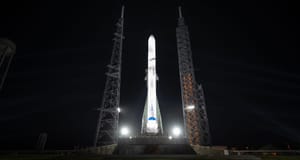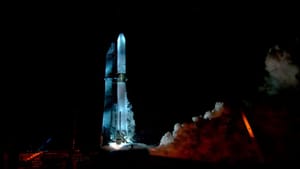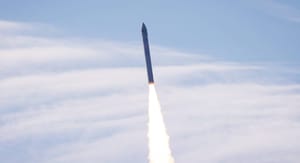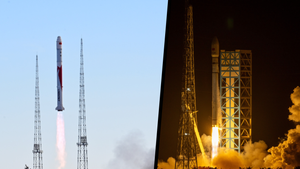
Feb 22, 2024
New Glenn emerges for testing
Surprising almost everyone yesterday, Blue Origin rolled its New Glenn rocket to its launch pad at Launch Complex 36 from its assembly building where components have been for the past few weeks. This is the first time the general public has seen an almost complete New Glenn vehicle.
The hardware on this New Glenn vehicle mostly does not consist of flight hardware with reportedly only the first-stage tanks being destined for flight. However, this vehicle will be at the launch pad for a few days to undergo tanking tests and connections to the ground support equipment. The tanking tests will see the vehicle potentially fully fuelled for the first time.
Currently, the vehicle does not have any first-stage engines installed but will have them installed depending on the results of the pad testing. Blue Origin's Senior Vice President for New Glenn, Jarrett Jones, said the following as the reasoning for the decision:
“We made the decision to not put the engines on because it’s not part of the test,” – “We’ll fill the tank up, make sure everything works with the fluids systems. It’s an integrated vehicle test, but it’s not firing the engines.”

The tank testing on the pad is a major milestone ahead of New Glenn's first launch, which Blue Origin is confident will happen this year. The landing barge needed to test the rockets' first-stage landing is also reportedly nearly ready for operation.
Blue Origin is also preparing the next three flights afterward having its fourth first-stage booster completing its assembly, the fairings for the first seven flights are also ready for flight. It is also believed that three second-stages are nearing completion for flight. Currently, Blue Origin is aiming to launch twice in 2024. Dave Limp, Cheif Executive Officer of Blue Origin, commented on the company's readiness saying:
“We’re going to show a lot of progress this year. I think people are going to see how fast we can move.”
Jarret Jones also disclosed that each New Glenn booster would be targeting a thirty-day turnaround time, from landing after a launch to being back on the pad. It was also disclosed that Blue Origin can launch twelve times in a year from beginning full operation with Jones adding:
"In reality, we can easily double that,” – “We’re bringing in equipment to get to 24 launches a year and we can do more.”
Long term, the New Glenn teams are also looking at ways to recover the vehicles' fairings and second-stage to further lower costs with re-use.

What is New Glenn?
New Glenn is Blue Origin's in-development partially reusable heavy-lift launch vehicle. The rocket is expected to be manufactured almost entirely by the company. New Glenn is expected to launch from Launch Complex 36 in Cape Canaveral, located in Florida.
Blue Origin claims that New Glenn will be able to send up to 45,000 kilograms to low Earth orbit when reused. It is also claimed that it plans to send 13,600 kilograms to a geosynchronous transfer orbit when reused. Blue Origin has not yet released any expendable payload capacity figures at the time of writing.

The first-stage is planned to be powered by seven BE-4 engines burning liquid methane and liquid oxygen to generate 1,746 tons of thrust for a currently undisclosed amount of time.
The second-stage is planned to be powered by two BE-3U engines burning liquid hydrogen and liquid oxygen to generate 145 tons of thrust, also for an undisclosed amount of time.
For recovery, New Glenn plans to use four fins located near the top of the booster, to control the boosters' descent when unpowered, and six landing legs that are stowed at the bottom of the booster during flight. It is currently believed that Blue Origin only plans to land the first-stage booster downrange on a drone ship.
On the launch pad, the rocket is 98 meters tall and 7 meters in diameter, Blue Origin has not yet said how much the launch vehicle weighs fully fuelled.



